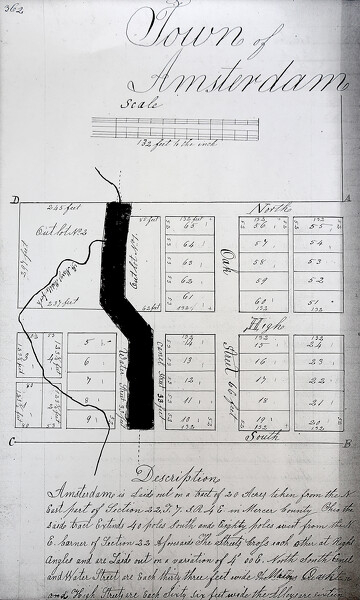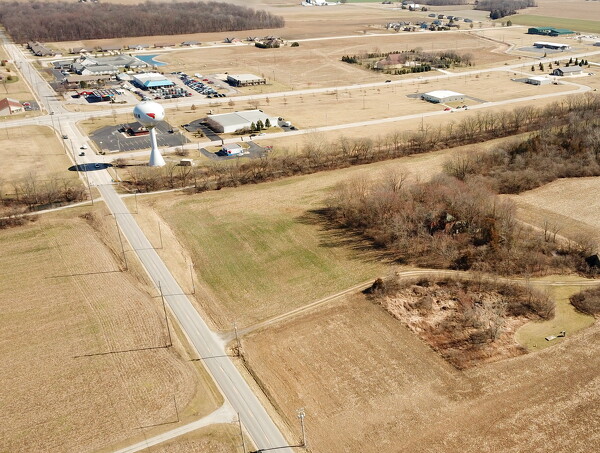
A plat map shows the layout of Amsterdam of 1849.
From the New Bremen Histoical Society
CELINA - At some point during the 20-season run of iconic Western television show "Gunsmoke," viewers purportedly learned that Dodge City's Doc Adams played by Milburn Stone had gone to the Macedon Medical School.
Whether or not that tidbit is indeed true, Macedon, a town founded in 1838 in Washington Township, about 7 miles west of preset-day Coldwater, had a population of 500 and four general stores, several saloons, a gambling joint, two hotels, a barbershop, a blacksmith shop and even a house of ill repute.
"Macedon is still there. It's a small, small burg, but it was a very big thing at one time," Mercer County Historical Society President Bill Vondrell told a crowd of 60 strong gathered at the Richardson-Bretz Building on Sunday afternoon. "But their demise was they did not want the railroad … and of course then it went to Coldwater and that was a big thing that really got Coldwater going."
Macedon was one of numerous towns highlighted during the historical society's well-received presentation of "The Lost Villages of Mercer County," culled from the limited amount of available documentation on many now vanished - and some remaining - settlements in Mercer County.
"There was a medical school there. It was not the oldest medical school in Ohio," Vondrell said.
The school, according to Mercer County Historical Director Cait Clark, was in possession of a human skeleton.
"When the medical school was closed and tenants moved in there, it's said that one of the tenants picked up the skeleton and threw it into the ditch out back, and with time, the floodwaters washed a majority of the skeleton away," she said. "But last we've heard … part of the skeleton or one or two bones are in possession by someone in Fort Recovery."
Historical society presenters for nearly an hour held the audience in rapt attention as they shared fascinating stories about other settlements, such as Walkatemoke, which was forged by a notorious fugitive in "muck land" unsuitable for farming known as The Black Acres or Cranberry Bog, west of Cranberry Prairie in Granville Township.
Walkatemoke was the twisted brainchild of William Simison, "a legendary and feared man of that region," who was constantly pursued for refusing to be conscripted into the Union Army.
Simison carved out a hideaway in The Black Acres, "a tangled, wild and treacherous morass" infested by copperhead and rattle snakes, Vondrell read from a document.
For his sanctuary, Simison chose an area of "the purest of black powdery muck in which humans or animals could be hopelessly mired."
"He was constantly sought by detachments of soldiers and also bounty hunters," Vondrell read. "Because of his skill and cunning and the aid of a few unknown friends, he seemed to live a charged life and was never brought to justice."
Simison's pursuers at times reportedly followed him to the edge of The Black Acres, "where he disappeared safely into its innermost fastness."
"The soldiers or bounty hunters dared not enter for it would have been almost certain death," Vondrell continued. "The safe trails to the hideout were known only to Simison."
Believed to be about a mile from modern-day Rockford, Old Town was a settlement of the Ottawa Indians, Vondrell said.
"I'm assuming it was called Old Town by the local people. I'm sure the Indians did not call it Old Town," he added.
Old Town likely vanished as a result of the Treaty of St. Marys in 1818, which forced all Native Americans from Ohio to the western side of the Mississippi River.
"This treaty actually forced a lot of the Native Americans that still had holdings from this area in Ohio. It pushed them further out of their Native lands," Clark explained. "Miami Tribe specifically following this treaty were completely forced to release their last landholdings in Mercer County."
Marcellus
Although the specific location of Marcellus is unknown, the town existed from 1858 to 1861. Postmaster Major James William Carlin, who had joined the 71st Ohio Volunteer Infantry, was captured by Confederates during the Civil War in 1864, according to Mercer County Historical Society Vice President Bill Sell.
Carlin was released from Andersonville, a POW camp known for its wretched conditions, at the end of the Civil War in April 1865. One of more than 2,000 people on the Sultana, a steamboat designed to hold 367 passengers, Carlin was on his way home to his wife and children when it exploded, killing him and 1,568 others.
Clark said it remains the deadliest maritime tragedy in U.S. history.
Burntwood was situated about 1 ½ miles east of Coldwater in Butler Township. It was home to North Burntwood School.
Dubbed the Plucky School Ma'am, Miss Alma Davis of St. Henry one day in 1911 took her students on a walk to Coldwater, pointing out "exhibits on the agricultural education train," according to a contemporaneous newspaper clipping.
"Back then, the teachers, like many of you do today, really took an extra step do that," Vondrell said.
Clark said the area today is the site of the Burntwood-Langenkamp Wetland Conservation Area. The property encompasses 88.9 acres and was purchased in 2021 using Clean Ohio funds for about $1.1 million and consists of 30-40 acres of wetlands, 10 acres of reforestation and the upland prairie habitat.
The Burntwood Cemetery is resting place of the Yancy family. Several of the family's children were lost due to smallpox, according to Clark.

Only the road between New Bremen and Minster bears the name Amsterdam now but 175 years ago a town with the same name sat on the banks of the canal.
Amsterdam, originally located between Minster and New Bremen, existed for just a few years from 1837-1849. Back then the area was still part of Mercer County, Sell said.
German immigrants in 1837 platted the 65-lot town of Amsterdam along the Miami and Erie Canal, according to an article in The Towpath, a quarterly newsletter of the New Bremen Historic Association
It had about 20 houses, several stores, factories, a grist mill and a distillery.
All of its residents fell victim to cholera.
"No man, woman, or child escaped the ravages of the awful disease," the article states. "There was no human being left to carry on. Their habitation decayed, returned to dust, and Amsterdam became a rapidly vanishing memory."
Sell said the bodies and "crude coffins" were collected at least twice a day and taken to the cemetery "without benefit of any religious services or mourning."
"When there's an epidemic, they just didn't have time," he said. "As terrible as it sounds, they knew … that if someone died of the disease, you had to bury them quickly and deeply, and that's what they did."
The town had a population of more than 700.
"They lost 150 in the three-week period between July 27 and Aug. 18 of 1839," Sell said. "So that was, I guess, about the height of the epidemic."
The residents were interred in a mass grave across from St. Paul's Church on North Herman Street in New Bremen. A public park was built over the graveyard in 1948 and the remaining headstones were laid flat and buried. Amsterdam's former plat was annexed into New Bremen in 1876.
